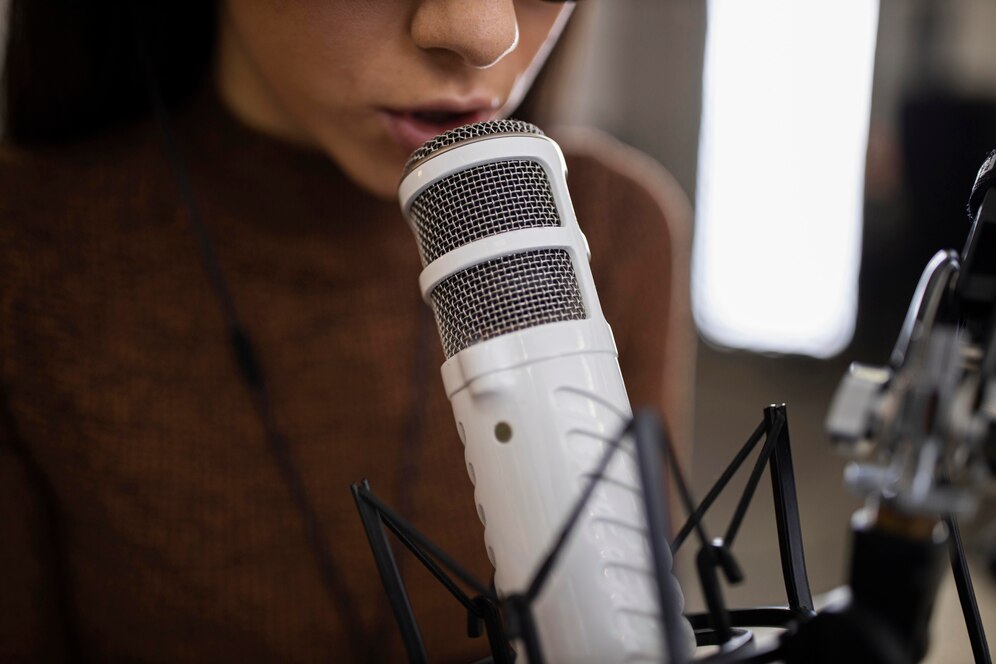Dynamic vs. Condenser Microphones: Which is Best for Voiceovers?

Introduction: Finding the Perfect Voiceover Microphone
Imagine stepping into a recording booth, script in hand, ready to bring words to life with your voice. Whether you’re narrating an audiobook, recording a commercial, or voicing a character for animation, your microphone plays a crucial role in defining your sound. But with so many options available, how do you choose between dynamic and condenser microphones for voiceovers?
This article dives deep into the nuances of each microphone type, helping you make an informed decision based on your specific needs. Whether you’re a seasoned voiceover artist or just starting, understanding the strengths and weaknesses of both microphone types will elevate your recordings to professional levels.
What’s the Difference Between Dynamic and Condenser Microphones?
At their core, dynamic and condenser microphones serve the same purpose—converting sound waves into electrical signals. However, their internal mechanics, sensitivity, and ideal use cases vary significantly.
Dynamic Microphones: Built for Durability and Versatility
Dynamic microphones use a diaphragm, voice coil, and magnet to capture sound. The diaphragm moves with sound waves, creating an electrical signal. This simple yet effective design makes dynamic microphones incredibly durable.
Pros of Dynamic Microphones:
- Rugged and Long-Lasting: Can withstand drops, humidity, and high sound pressure levels.
- Lower Sensitivity: Reduces background noise, making them ideal for untreated rooms.
- No External Power Required: Unlike condensers, they don’t need phantom power.
- Affordable: Generally more budget-friendly than condenser mics.
Cons of Dynamic Microphones:
- Limited High-Frequency Detail: They may lack the clarity and crispness of condensers.
- Lower Sensitivity: Requires more vocal projection or additional gain.
Condenser Microphones: The Gold Standard for Studio Voiceovers
Condenser microphones utilize a lightweight diaphragm and a backplate, forming a capacitor that reacts to sound waves. They require phantom power (usually 48V) to operate, often provided by an audio interface or mixer.
Pros of Condenser Microphones:
- Highly Sensitive: Captures subtle nuances and details in voice.
- Wide Frequency Response: Produces natural and clear sound reproduction.
- Ideal for Studio Use: Best suited for quiet, acoustically treated environments.
Cons of Condenser Microphones:
- More Fragile: Sensitive to humidity, temperature changes, and handling.
- Requires Phantom Power: Needs an audio interface, mixer, or dedicated power source.
- Picks Up Background Noise: Not ideal for untreated rooms or noisy environments.
Dynamic vs. Condenser Microphones: A Feature Comparison
| Feature | Dynamic Microphone | Condenser Microphone |
|---|---|---|
| Durability | High | Moderate |
| Sensitivity | Low | High |
| Sound Quality | Warm, solid | Clear, detailed |
| Background Noise Rejection | Excellent | Moderate |
| Best For | Live settings, untreated rooms | Studio, controlled environments |
| Power Requirement | None | Phantom power (48V) |
| Price Range | Affordable | Typically more expensive |
Choosing the Right Microphone for Your Voiceover Needs
Consider Your Recording Environment
If you’re recording in a professional studio with acoustic treatment, a condenser microphone is often the best choice due to its sensitivity and clarity. However, if your setup is in a home office with background noise, a dynamic microphone will help reduce unwanted ambient sound.
Your Vocal Style Matters
A deeper, richer voice might sound better on a dynamic microphone, as it naturally rolls off higher frequencies. If you have a softer or higher-pitched voice, a condenser microphone will capture more detail and clarity.
Budget Considerations
If you’re just starting and looking for an affordable but professional-quality option, dynamic microphones like the Shure SM7B or Electro-Voice RE20 are excellent choices. For high-end studio recordings, Neumann TLM 103 or Audio-Technica AT4040 are some of the best condenser microphones available.
Common Myths and Misconceptions About Voiceover Microphones
Myth 1: Condenser Microphones Are Always Better
While condensers are known for their detailed sound, they aren’t always the best choice for every setting. A dynamic microphone may be superior in noisy or untreated environments.
Myth 2: More Expensive Means Better Quality
A $1,000 microphone won’t necessarily make your voiceovers sound better if your recording space isn’t optimized. Proper mic technique, room treatment, and audio processing play a significant role in achieving professional-quality recordings.
Myth 3: USB Microphones Can’t Be Professional
High-quality USB microphones like the Shure MV7 and Rode NT-USB+ are bridging the gap, offering studio-grade sound in a plug-and-play format.
FAQ: Everything You Need to Know
1. Can I use a dynamic microphone for professional voiceovers?
Absolutely! Many professionals use dynamic microphones like the Shure SM7B, especially in environments where background noise needs to be minimized.
2. Why do most studios use condenser microphones?
Condenser microphones offer superior detail and a wider frequency response, making them ideal for capturing vocal nuances in controlled studio settings.
3. What’s the best budget microphone for voiceovers?
For dynamic mics, the Audio-Technica ATR2100x is a solid choice. For condensers, consider the Audio-Technica AT2020 or Rode NT1-A.
4. Do I need an audio interface for a condenser microphone?
Yes, most condenser microphones require phantom power (48V), which is typically provided by an audio interface like the Focusrite Scarlett 2i2.
5. How can I reduce background noise in my recordings?
Using a dynamic microphone, setting up proper acoustic treatment, and employing noise reduction software can significantly minimize unwanted noise.
Conclusion: Which Microphone Should You Choose?
The best microphone for voiceovers depends on your unique needs, budget, and recording environment. If you’re working in a controlled studio, a condenser microphone will offer superior clarity and detail. However, if you’re recording in an untreated space or need durability, a dynamic microphone is a smarter choice.
No matter which you choose, great voiceover work is about more than just the mic—proper mic technique, room acoustics, and post-processing are just as important. Invest wisely, experiment, and refine your craft to find the sound that works best for you!






